A view from Fira toward Skala, the old Santorini port where cruise passengers disembark from tender boats, 220 meters below the town. The ferry port at Athinios, 7 kilometers to the south of Fira, isn’t able to accommodate cruise ships.
Another view of the dock area from a terrace in Fira. There’s no room for cruise ships to dock at the small port below Fira, so thousands of passengers must be tendered ashore.
The cable car website says the lift can move 1,200 people per hour between the port and Fira — which often isn’t adequate capacity for the demand, considering that just one cruise ship, like the Celebrity Equinox, can carry more than 2,800 passengers.
On some days half a dozen or more cruise ships may anchor below Fira. It can take as long as 2 or more hours for passengers to travel from their ship to the cable car station in Fira. Some passengers will trek up and down the cliff on foot, but each day during peak travel season hundreds more will hire a donkey to carry them instead.
Donkeys (center left) stand in the afternoon sun on the stepped path below Fira, waiting to be pressed into service carrying cruise ship passengers down the cliff to the tender boat dock
More “taxi” donkeys stand waiting for fares on the path just below Fira
Screenshot of an article published October 30 2007 by The Daily Express
[adToAppearHere]
Newspaper launches “Save The Donkeys crusade”
For the past six years, travellers have been posting “don’t ride the donkey” messages on the Santorini forum board on TripAdvisor.com, often referring to a “Let’s Save The Donkeys crusade” launched in 2007 by the U.K. publication The Daily Express. The newspaper spearheaded the protest project in a bid to help end the cruelty that many of the island’s donkeys and mules endure by carrying tourists — many of whom are obese, and weigh just as much as the animals themselves — up and down the steep cliff path multiple times per day in blazing sunshine and extreme summer heat.
In an October 30 2007 report on its donkey ride boycott campaign, The Daily Express said it had been “inundated with hundreds of messages of support from readers determined to end the archaic and cruel practice.” And in a promising development, at least two major cruise operators said they had begun advising passengers to take the Santorini cable car instead of riding donkeys, the paper reported.
But efforts to assist the animals actually started in 2006 under the guidance of the late Dr Elisabeth Svendsen, founder of The Donkey Sanctuary, a U.K.-based organization that is the largest donkey and mule charity in the world. According to a May 19 2008 post on the group’s website, the sanctuary had been providing free veterinary care to the Santorini donkeys for several years, while Dr Svendsen had played an instrumental role in the establishment of the cable car system that transports the vast majority of cruise ship visitors to and from Fira. Moreover, the Sanctuary was “working with the local authorities to implement a code of practice, which should help improve the working condition of these animals,” the group’s web post said.
Nevertheless, hundreds of cruisers and other tourists continued to ride the donkeys daily, and mules were still suffering two years after The Daily Express launched its campaign. “We witnessed donkeys with weeping sores forced to heave giggling tourists up the steep and tortuous path when we returned to the Greek island yesterday. The donkeys now face yet another gruelling summer ferrying overweight holidaymakers from cruise ships up 680 steps to the island’s capital,” the newspaper reported in a May 23 2009 follow-up article.
Screenshot of the follow-up article published May 23 2009 by The Daily Express
Code of conduct created in 2009
But that very same month, The Donkey Sanctuary achieved a significant breakthrough when its team of veterinarians, dentists, farriers and welfare officers performed, for the first time ever, health checks on 120 mules and donkeys — an endeavour undertaken in co-operation with the Municipality of Fira. The team also checked to ensure that the animals were being treated properly, as well as to give guidance to the animals’ owners about the new code of conduct — put in place just in time for the 2009 summer tourist season — that would govern how the animals were used.
“Initially, the donkey owners were reluctant to bring their donkeys to our team or take off their donkeys packs, but they soon realised that we were there to help.” the Sanctuary noted in a May 29 2009 entry on its website. “We issued new harnessing to make life more comfortable for the donkeys and those who didn’t pass the health check won’t be allowed to work under the new scheme until the owners can prove their animal is fit to work once again.” In addition, the president of the local donkey owners’ association “has agreed to ensure the donkeys receive water and shelter when they are not working and improve the system of loading/unloading passengers.” For its part, the Sanctuary agreed to carry out further animal health checks twice annually.
The Daily Express reported on the donkeys’ new harnesses. “Some of the animals have already been kitted out in new equipment, including padded, breathable blankets and stainless-steel stirrups. Fitting out the donkeys will cost almost £12,000. Fortunately, Greek easyJet billionaire Sir Stelios Haji-Ioannou joined our crusade and pledged £24,000 a year to help the animals.”
Screenshot of a May 29 2009 post on The Donkey Sanctuary website
Donkeys stand on the steps below Fira near the end of a long working day
A donkey owner mounts one of his animals …
… then leads three more donkeys up the stairs into Fira at the end of their shift
A pack of mules passes the cable car station in Fira at the end of their work day
[adToAppearHere]
Program support withdrawn
Unfortunately, the health care and code of conduct program suffered a setback in its first year. In a June 8 2010 post on its website, the Sanctuary reported that complaints from tourists, together with its own spot checks, had “revealed that standards slip whenever the charity is not present on the island.”
“It seems that when our back is turned, the abuse begins all over again. Donkey masters beat the animals, we even witnessed one of them holding on to the tail of a mule to pull him up the hill. It’s just not acceptable and, as a charity dedicated to the protection of donkeys and mules, we are not about to sit back and let this continue,” said the Sanctuary’s director of European operations, Paul Svendsen.
In a subsequent website posting, the Sanctuary said it was “sad to announce that because of their continued lack of effort to improve working conditions for the donkey taxis, we can no longer support them. Having helped the Municipality to set up a code of practice which governed the use of the donkeys on Santorini and providing the owners with free veterinary care and advice for their animals, we recently discovered that the whole operation was a sham and that the procedures were only being adhered to when we were visiting the island! This tied in with reports from tourists who gave a completely different account to the situation we were being shown during our visits,” the Sanctuary reported on its website. “Unless the Municipality and the donkey owners make major improvements to the working conditions for the donkey taxis and their terrible refuge, we plan to escalate this major campaign further.”
As an alternative course of action, the Sanctuary undertook a petition and email campaign to bring the issue to public attention in a bid to pressure Santorini municipal officials into taking appropriate corrective action. The campaign also aimed to alert cruise ship lines about the problem, and to encourage them to advise passengers not to ride the donkeys during their port calls at the island.
Webpage screenshot of The Donkey Sanctuary’s petition campaign
Donkey owners fined for breaching rules
The international petition proved effective. In an October 13 2011 post, the Sanctuary’s website reported on renewed hope for improvement in the donkeys’ welfare — municipal authorities in Fira had begun enforcing, with fines, the code of conduct governing donkey taxi operations. One of the regulations being enforced was a strict limit on the number of donkeys or mules that an operator could use to taxi tourists on any given day.
According to the website report, Christina Kaloudi of the Santorini Animal Welfare Association (SAWA) stated that: “For the first time ever, €200 fines were issued in September 2011 to ten donkey taxi owners who breached the law by bringing more than seven animals to work. The Vice Mayor of Santorini announced at a recent meeting with the taxi owners that things are not going to be the same anymore and that the fines will not be cancelled. If the owners do not pay the fines they will receive the fines through the tax office.”
For its part, the Sanctuary urged tourists to “keep a close eye on the condition of donkeys and mules,” and ride a donkey taxi only after they had checked to see if it appeared obvious that the animal had food, water and rest, and that its harness equipment was in good condition. The Sanctuary also suggested weight guidelines: tourists weighing more than 50 kilos shouldn’t ride donkeys, while people 80 kilos or heavier shouldn’t ride mules. The Sanctuary also encouraged visitors to send it any information — including photos or videos — if they had any concerns about the welfare of donkeys and mules on Santorini.
[adToAppearHere]
Regular island visitors raise awareness on travel forum
Meanwhile, on TripAdvisor’s Santorini forum, regular island visitors have continued to warn other travellers to stay off the donkeys’ backs.
“PLEASE DON’T RIDE THESE POOR ABUSED ANIMALS!” urged brotherleelove, the popular TripAdvisor Destination Expert for Santorini, in his June 29 2012 reply to a question posted on the forum. It’s an exhortation he makes numerous times each year while answering thousands of questions about the island, which he has been visiting for decades and knows practically inside-out.
“I have personally witnessed the donkey men’s dirty little secret. What most riders don’t see because they’re facing forward (and the donkey men are behind their animals) is that the sticks they use to prod the animals have a removable metal tip, like the end of a nail, that these men can put into the end of their stick to jab the animal to keep it moving, and then put it back in their pocket to keep it out of sight when they don’t need it,” brotherleelove explained in his post.
TripAdvisor Santorini Destination Expert brotherleelove regularly advises travellers against riding the donkeys when they visit the island
Bigsnitch, TripAdvisor.com Destination Expert for Santorini’s Perissa resort area, also repeats the “don’t ride the donkeys” refrain regularly. “Imagine trudging up and down a near vertical cliff face all day, every day, with a sweaty tourist on you back, with minimal shelter, water and food and being beaten by your sadistic owner. Donkeys have been used for centuries as beasts of burden and as such are generally well cared for (yes, there are exceptions), as they’re seen as an important part of a farming community, but these poor animals are simply being exploited for the “pleasure” and “fun” of pampered foreigners, and the sooner this practice is stamped out, the better,” he wrote in an April 22 2012 post on the Santorini forum.
The most recent exhortation not to ride the mules came from Kennydon, a Destination Expert for nearby Thirassia island, who pleaded “Please don’t ride the poor abused donkeys!” in a March 21 2013 reply to a question about the Santorini cable car.
Agreeing with bigsnitch’s comments a year ago was Kalamata region resident Yiassas, a Destination Expert for the Peloponnese, Stoupa, Finikounda, Petalidi and Athens, who also appealed to TripAdvisor readers with “a plea not to (ab)use the donkeys.
“I’m in a rural area & still occasionally see donkeys working as they are meant to be, take owner to fields in the morning, rest under the shade of a tree, with food & water, while their owner works the land, then the donkey carries any produce home later. That’s more like it, not continuous up & down a very steep & bendy cliff all day in full sun, often carrying weights far in excess of what is comfortable for them. Anyone who still uses one after being informed is as guilty of abuse as the owners are,” Yiassas said.
On other islands, including Amorgos, Astipalea, Folegandros, Naxos, Patmos and Sifnos, I’ve seen donkeys being used in the traditional manner Yiassas described, rather than as taxis to ferry tourists up steep footpaths. However, on one of our Santorini trips we did see mules carrying bags of concrete mix and other construction supplies (see below) for a man who was building an addition to a house between the villages of Firostefani and Imerovigli. During a visit to Patmos, we saw mules carrying big bales of hay at a farm near Stavros beach. And on Amorgos, locals told us that donkeys and mules must be used to haul building materials and household supplies to residences in mountain villages that are not accessible by motor vehicle.
The pathway and cable car line between the port and Fira can be seen cutting diagonally across the photo in this view from high above.
Donkeys are forced to make continuous trips up and down the long path, most of which is fully exposed to the brutal heat of blazing summer sunshine.
Although more than 300 mules and donkeys work as tourist “taxis,” there are hundreds more of the animals on Santorini, some of which are employed in other capacities
We photographed these three mules as they climbed a hillside path between the clifftop villages of Firostefani and Imerovigli
They, and two more mules following behind, were carrying construction materials for a tradesman who was building an addition to a house several hundred meters away
A local man leads a pack of donkeys down a path in Firostefani, en route to Fira
We passed these donkeys while walking from Fira to Firostefani one morning
The animals were being led to the cliff path below Fira to transport cruise ship passengers who would be arriving at the island that afternoon.
[adToAppearHere]
Sanctuary sees gradual progress from its efforts
Since many of the “don’t ride the donkey” posts on TripAdvisor.com keep providing links to the 5-year-old articles from The Daily Express, I contacted The Donkey Sanctuary to ask if there has been any recent news to report. They generously provided me with updated information … and it’s positive news.
A Sanctuary statement says the organization is “gradually making progress” for the estimated 360 donkeys who work as tourist taxis on Santorini (out of the more than 2,000 donkeys and mules that live on the island).
“Through the Town Council of Santorini, The Donkey Sanctuary is hopeful that a new system of fines and a proposed training program will lessen the mistreatment of overworking donkeys and mules. The council’s new Mayor has shown a definite interest in making improvements for the donkeys and enforcing rules. He agreed last year that the council and Donkey Sanctuary will review the Codes of Practice that will help to implement and organise training courses for the vets, police and donkey owners in donkey care,” a Sanctuary press statement says.
Also in 2012, the Sanctuary met with Santorini’s Vice Mayor and the Santorini Animal Welfare Association, and several significant changes followed.
“Six new sun shades have been erected at the top of the steps to keep the donkeys out of the sun while they are resting; Smaller donkeys have now been replaced with much larger mules who are better suited to the work, and The Donkey Sanctuary has agreed to supply water troughs for the taxi donkeys and new tack to owners who follow the systems and procedures,” the media release notes. More improvements are anticipated in the course of the next year, including set-up of a new mounting area; improvements to the shelter at the bottom of the steps; creation of a barrier at the bottom of the steps to force all owners to lead their donkeys through the bottom shelter area; and ensuring that every working donkey is covered by insurance for public liability.
“The authorities will continue to fine any owner who does not comply with the codes of practice which the Sanctuary will monitor to ensure this is being done, ensuring a safer system of work for each working donkey. The Mayor has also stated that he wants to improve the areas for the donkeys when they are not working, allowing the donkeys and mules to have a longer rest.”
Tourists ride donkeys down the cliff path to the small port below Fira
The two sets of cable cars pass midway up the cliff. Though there can be lengthy line-ups and long waits to board the lift, some cruise lines now urge their passengers to ride the cable cars instead of the donkeys.
A bottleneck of tourists on donkeys — and some on foot — clogs one of the hairpin turns on the cliffside path. If you visit Santorini and decide to walk up or down the trail, tread carefully — the steps often can be slick with donkey poo and pee.
Group aims for public awareness of donkey’s plight
The Donkey Sanctuary’s Head of European Operations, Andrew Judge, says the new system of fines “represents a real breakthrough in the recognition of animal welfare on the island. After years of campaigning, and working closely with SAWA and the local authorities, we have established a code of practice in the Town Council of Fira, setting out acceptable standards of animal welfare and ensuring that only animals fit enough to work are allowed to do so. We aim to raise awareness for people to think about the donkeys and mules and the weight that is being placed on them. The Donkey Sanctuary is there to work with the locals and town council, in order to help improve conditions for the donkeys and the public. We do have partners who monitor the situation for us on the island and we will continue to monitor and assess the situation in the future.”
More good news: when the Sanctuary conducted an inspection last October, it found that “most of the cruise ships are now warning the visitors not to ride the donkeys and mules as it is not safe, and due to insurance.” And only a small percentage of the passengers who arrived in port on four cruise ships made their way up to Fira on donkeys.
For tourists who feel compelled to ride a donkey, the Sanctuary recommends they take a close look at the animal first to see if it looks well rested, fed and watered, and to check that its harness equipment is in good shape. They should take a close look at themselves, too, and consider if they’re too heavy for the animal to carry (maximum weight of 50 kilos for a donkey, and 80 for a mule).
I urge visitors to do the right thing and take the cable car instead.
Of course, you can always hoof it yourself and climb the 590 steps between the port and Fira (then walk them once more on the way back down). It’s great exercise, and will help work off all the calories accumulated from the cruise ship buffets.
But I’ll never forget the story that a friend told me about someone they know who decided to walk down the path because he didn’t have patience to queue in the long line outside the cable car station in Fira. It was an extremely hot day last August and this fellow was smartly dressed in a natty white linen shirt and trousers, and expensive new Italian loafers. Partway down the path, he slipped on a step that was slick with donkey poo and urine, landing flat on his ass on the ground. Covered in smelly excrement, he had to endure a humiliating ride back to the ship on a tender boat full of passengers who held their noses while snickering at his poo- and pee-stained designer duds.
The €4 cable car ride sounds much more sensible now, doesn’t it?
[Editor’s update: Click here to read my June 14 2014 update to this article.]
Above is a link to my Donkeys and cable cars on Santorini Flickr album containing larger versions of the photos that appear in this post. Click twice on the image to access the album.


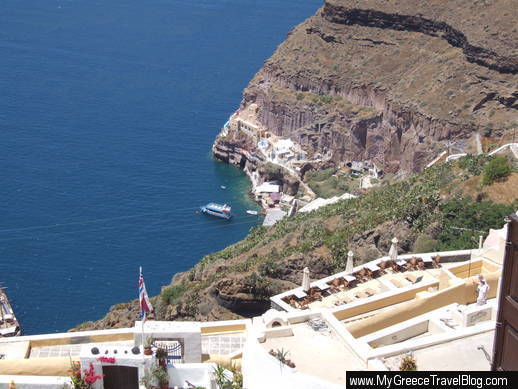
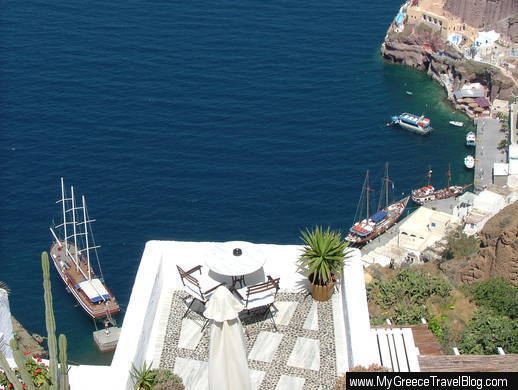
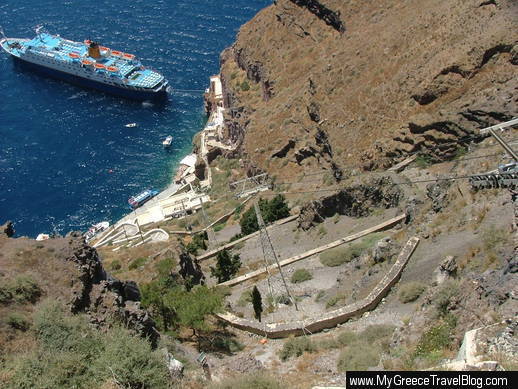
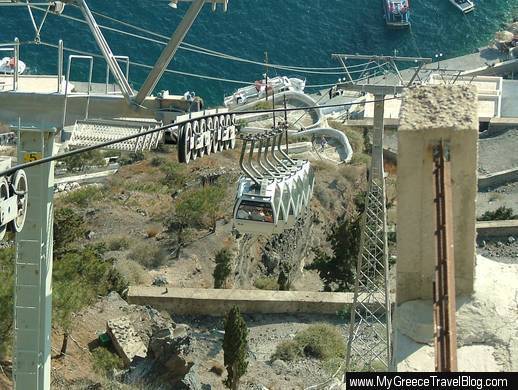


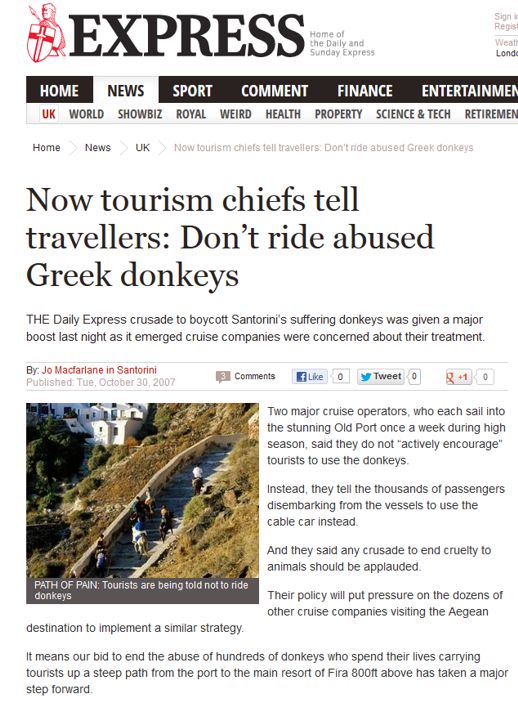
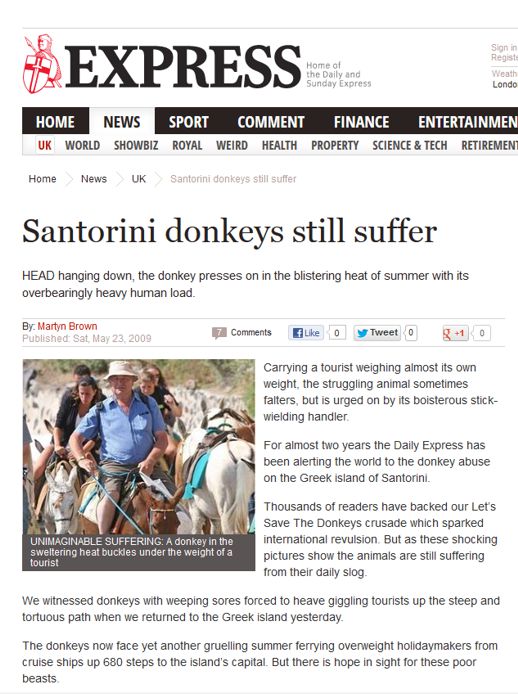
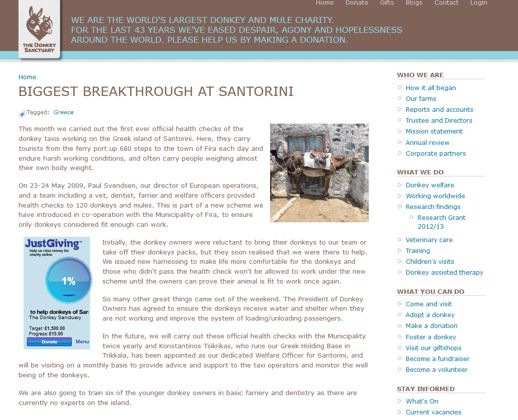


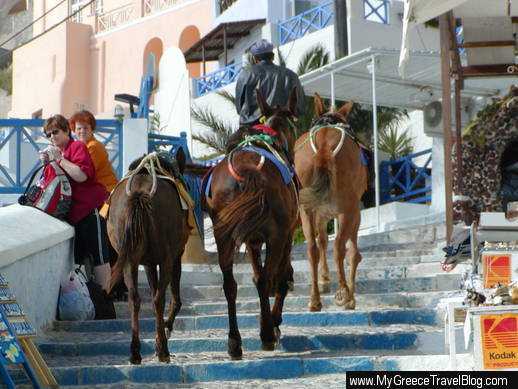
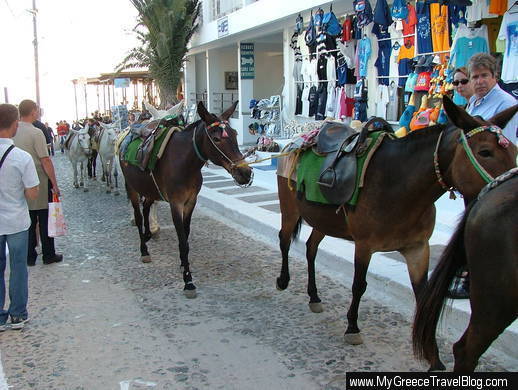

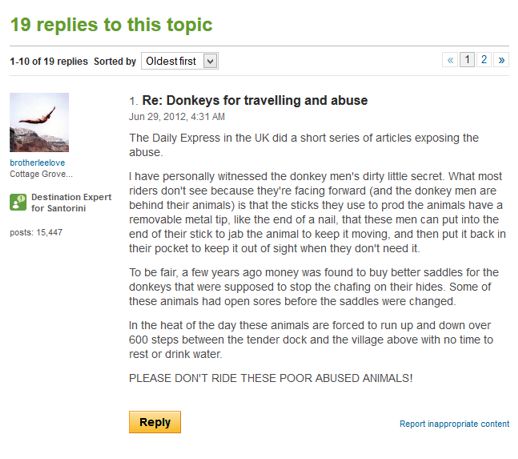
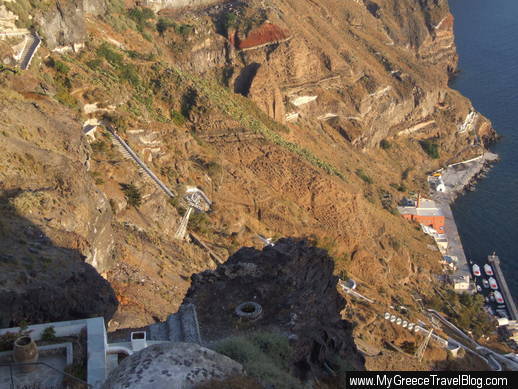

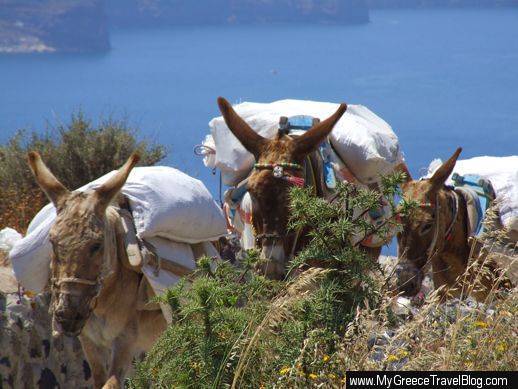
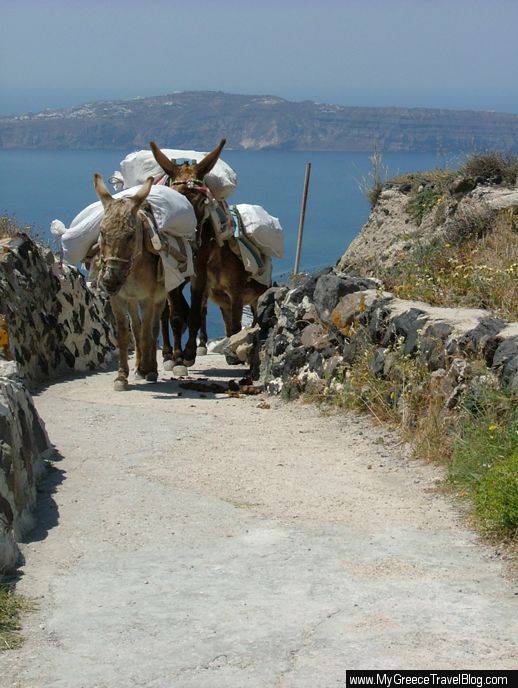
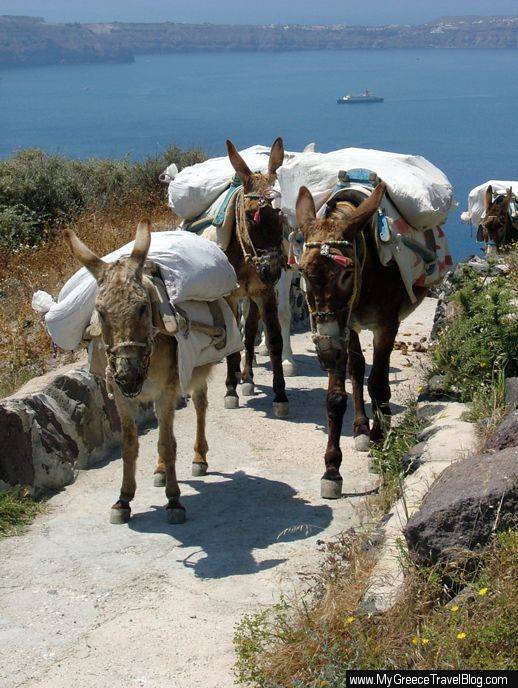
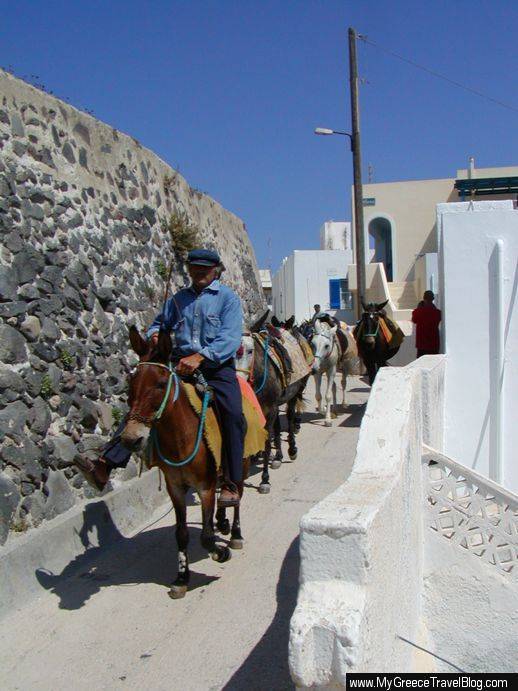
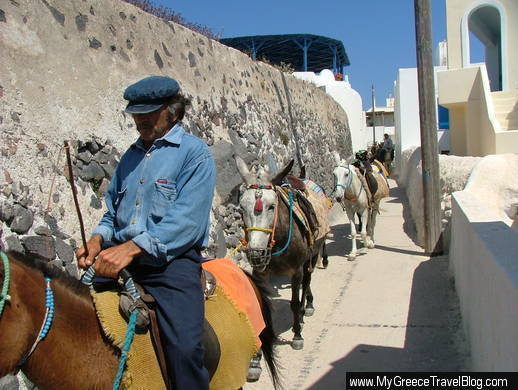

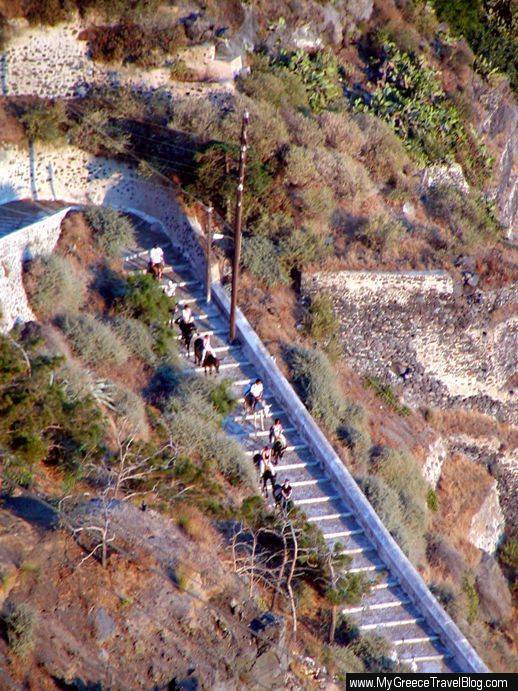
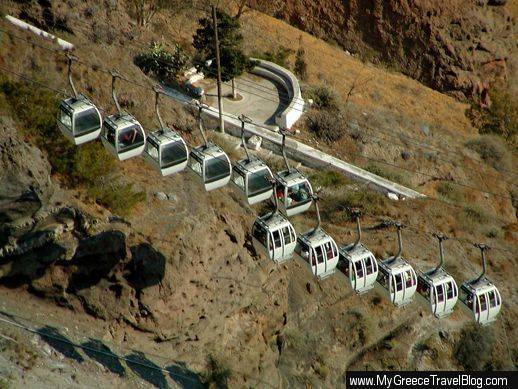
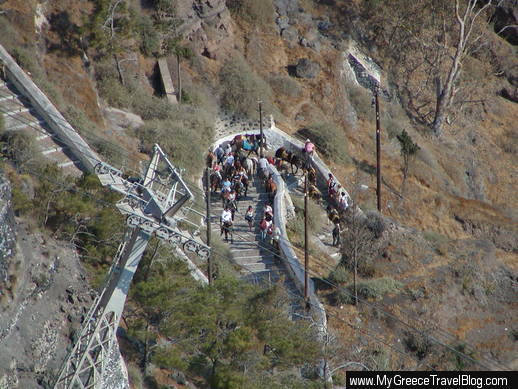
Leave a Reply